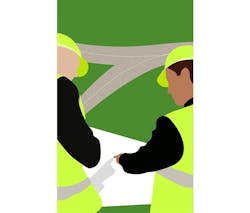Tom Williamson, owner of the three-location Marina Auto Body in Southern California, never planned on owning more than one shop. When the right opportunities presented themselves, though, he took advantage—even if that meant juggling a number of elaborate projects at once.
Williamson recently opened his new location in Englewood, all while maintaining his facility in Marina Del Rey and preparing to transition his Redwood location from a full body shop to a customer care center that will be strictly for estimates, drop-offs and pickups. Managing all of these different projects may seem overwhelming, but Williamson was able to do it all thanks to the help of his team, specifically his paint and spray booth distributor, Al Ortiz, president of Rely-On Technologies. Ortiz took on the role of Williamson’s general contractor and helped him find the right location and navigate the various regulations that the city had for the new collision repair shop in Englewood. Williamson says he wouldn’t have been able to do it without Ortiz.
Strong Recommendations
For shops owners that are looking to open a new location or move into a new market, finding someone that knows what to look for in a building is a must. Going to the Yellow Pages and hiring a contractor might work out, but it’s risky. Williamson found Ortiz by talking to his peers in the industry. Ortiz came with strong word-of-mouth recommendations from people that Williamson trusted, so he contacted him. The two have been doing business together now for about 30 years.
Ability to Picture the End Result
When Williamson began looking for his new location, he knew what he wanted: a newer property, a large facility with plenty of parking, and a building that was close to his other locations. Working with a broker, Williamson was able to find the Englewood property before it even hit the market. However, without Ortiz’ vision of the shop, he may not have ended up where he is today.
Williamson and Ortiz looked at locations for a year and a half before deciding on Englewood. At every location they looked at, Ortiz would take the space and create a computer-aided designs (CAD) to show Williamson how the building would look once everything was finished. Williamson says it’s important to find someone who understands the flow of the shop and how all of the equipment will work together.
“Some of the shops looked really good when we walked in,” Williamson explained. “After Ortiz drew up the CAD, we found out that there was one factor or another that wasn’t ideal.”
Ortiz, being a distributor of spray booth equipment, knew the exact measurements and requirements for the equipment, so he was able to envision where everything would need to go in the shop. Ortiz was also familiar with important facts, like the average size of a tech’s stall and how long it can take a repairer to do a certain job. Because of this, Ortiz and Williamson were able to go into each location and determine how many cars each location would be able to repair in a month.
“Working with Ortiz, there was no guesswork,” Williamson said. “We knew exactly what to expect from each building.”
Knowledge of Regulations
Once Williamson decided the Englewood location was the right fit, the plans had to be approved by City Hall. Ortiz, having experienced this before, knew exactly what the city would be looking for when the time came. Since Williamson was planning on various projects, including replacing power and electrical; adding and cutting concrete; and installing a spray booth, Ortiz drew up detailed plans to show what exactly they planned on doing.
Each time Williamson decided to change something in the building, City Hall had to be notified of it. Ortiz knew exactly the type of information that the city would be looking for, so he was able to bring that information and present it, which made the process of going to City Hall stress-free for Williamson.
City Hall wasn’t the only place that Williamson had to get clearance from. Along with the requirements placed by the city, Williamson also had to get his plans cleared by each municipality. Ortiz knew that even though the requirements may pass at City Hall, it didn’t mean that it would pass the inspection from the electrical company. One example of this was that the electrical company in Englewood required a breezeway between the room with the meter and the repair center itself so that the inspectors were not subjected to any airborne contaminants when they read the meter. This was not a City Hall requirement, but Ortiz was on top of it and knew the electrical company would require it.
Ortiz was able to draw up plans for the shop that would pass all of the inspections, which was essential for Williamson. City Hall and the inspectors didn’t provide any type of resources or aid for Williamson to go off of, so without Ortiz, he would have been in the dark.
Connections
Working as a spray-booth distributor, Ortiz was familiar with the industry and had cultivated many relationships. Because of this, Ortiz knew which companies to work with and was able to negotiate on the cost of equipment and subcontractors saving Williamson money in the end.
Communication Skills
During the process of locating and remodeling the building, Williamson and Ortiz kept in constant contact. When they weren’t together, they got in the habit of talking every other day. Williamson said that Ortiz was easy to get in touch with and that their similar schedules allowed them to speak early in the morning. Ortiz updating Williamson on the progress of the new shop allowed Williamson to work at and concentrate on his other locations.
When it came to working with Ortiz, Williamson said there were no surprises. When scouting buildings, Ortiz was able to draw up plans and quote Williamson a final price for each building. The final cost for the building remodel and new equipment came in at about $750,000, which was what Ortiz quoted. Williamson never felt left out of any decision or unaware of what was happening during the remodel.

